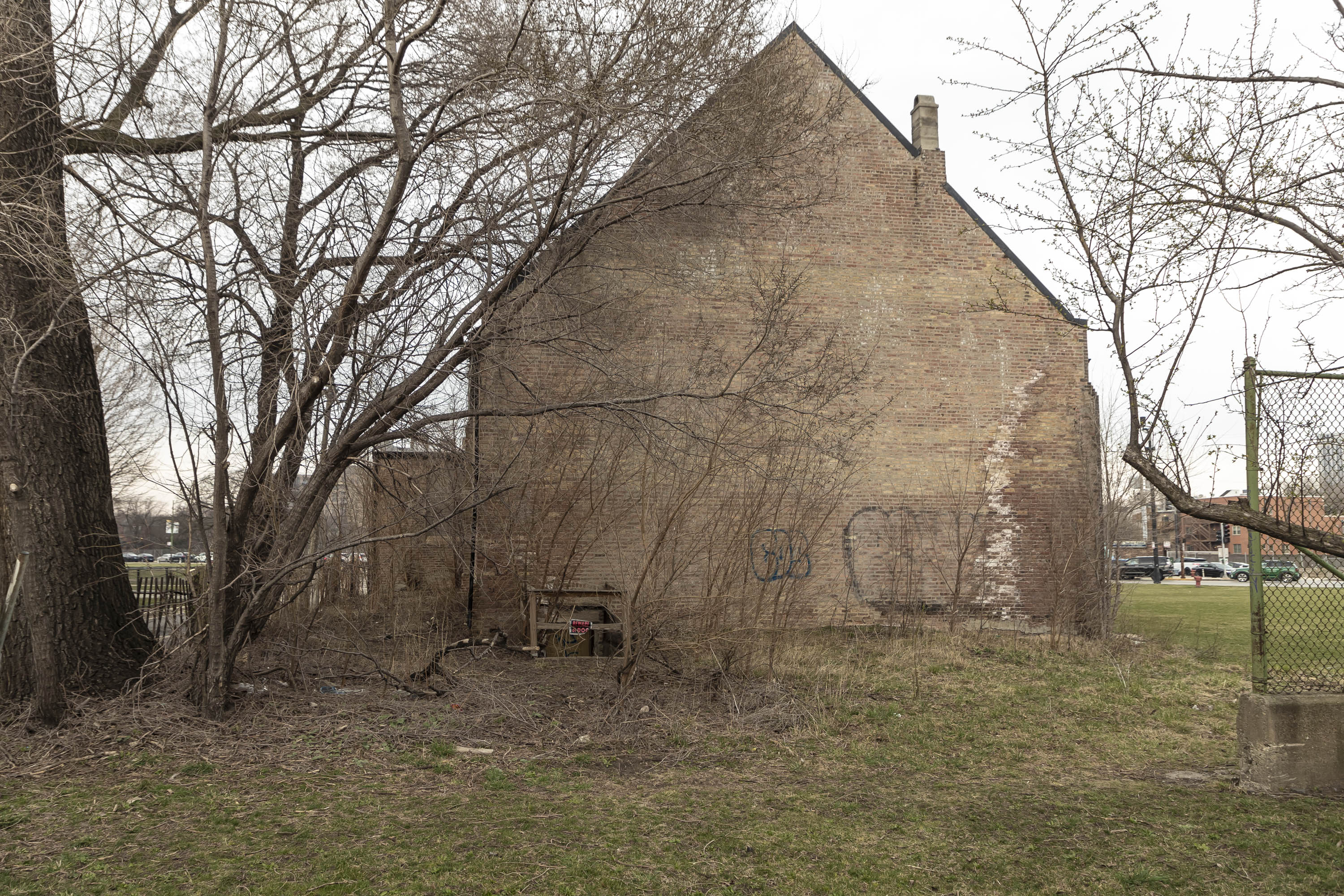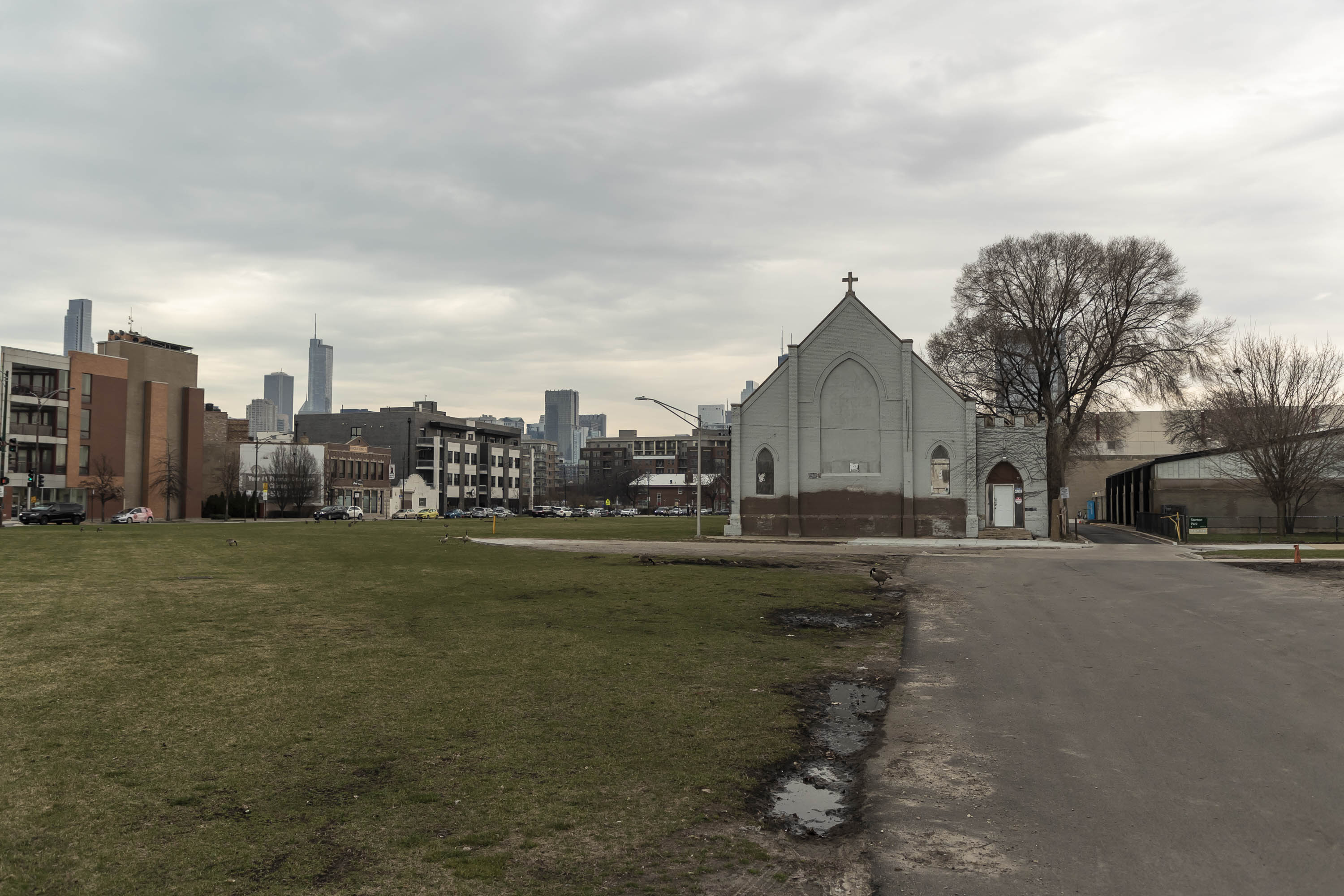Surrounded by a broad swath of vacant land along Clybourn Avenue and Larrabee Street is a curious building, its face painted a plain gray. The structure is clearly a former church of some kind, with familiar arched Gothic, boarded-up windows and a cross rising from its peak.
The building has a remarkable history, and if several groups that are working together get their wish, it will have an even more remarkable future.
They’re a coalition of former Cabrini-Green residents, entrepreneurs and preservationists of both architecture and art. They’ve been working for years to revive the building, an isolated remnant of Cabrini as it was in the 20th century. But in recent weeks, the group has been getting more visibility since Preservation Chicago put the building on its 2024 list of the seven most endangered sites in the city.
They’re all “coming together to reclaim this place,” said Marques “Merk” Elliston, who with fellow former Cabrini-Green resident Cher’Don Reynolds is trying to raise money to buy the building from its present owner and reopen it as Cabrini Art House. The goal, he told WBEZ’s Reset, is to “restructure, rebuild and have a place to come back to.”
Putting this place right again more than a decade after the last of the Cabrini-Green residential buildings were torn down would “give our city a chance to make good on its promise to give the people (who lived in those buildings) the right to return,” said Henry Wishcamper, whose group, Bustling Spaces, is working with Elliston and Reynolds. “If not an actual place to come back and live, then a symbolic place to return.”
The vision has a close cousin in Cape Town, South Africa. The District 6 Museum, located in an old Methodist church, enshrines the Black history of the neighborhood — both when the racist apartheid system forced the longtime Black residents out in the 1960s and when they returned in the 1990s after the regime fell.
For now, the building at 617 W. Evergreen Ave. is as blank as it looks, a 123-year-old church now used for storage.

Seeing the structure today, boarded up and bland, it’s hard to imagine that from 1972 until 2015 this was one of the most visually alive and intriguing spots on the map of what was then the Cabrini-Green neighborhood, dominated by Chicago Housing Authority buildings.
Before it was painted over in gray, the entire front façade and much of the sanctuary inside was covered with “All of Mankind,” the work of William Walker, a pioneering Black mural artist. He covered the façade with the image of a cluster of people of different races all clasping hands and surrounded by names including Malcolm X, Anne Frank, John and Robert Kennedy. Above it were the words, “Why were they crucified.” The phrase was painted over in gray in 2015.
Inside the sanctuary, Walker portrayed a large number of people, mostly Black, working, worshiping and teaching, with an image of a family prominent in the center. That was whitewashed in 2004, according to the book about Walker called Walls of Prophecy and Protest by Jeff Huebner.

None of the mural is visible anymore, though it may all still be there, concealed by a few layers of paint. Wishcamper said art conservators have done some preliminary testing on the exterior — guerilla-style, with no support from the building owner — and they believe that if the interior is in the same condition, the mural can be fully restored.
The groups’ overall vision for the building entails creating a nonprofit cultural hub and gathering space on the main floor and for-profit businesses in the basement, including Reynolds’s branding and promotional agency, She Prints It, and Elliston’s events and marketing firm, Dsgnrz.
All told, it’s about a $10 million project, Wishcamper said. But the first step, which they’re fundraising for now, is smaller: just buying the building.
How much do they need? That’s a tough question. The owner hasn’t said he’s willing to sell and hasn’t said what his price would be.
The present owner, a legal entity headed by a man named Marc Bortz, paid $750,000 for the building in 2018, according to Cook County and state of Illinois records. Bortz’s entity bought it from Gary and Erin Rossi, who bought the site in 2016 from the Northside Strangers Baptist Church, which had been in the building since 1974. The public records don’t say what the Rossis paid.
Neither Bortz nor an attorney listed on the legal documents responded to Reset’s interview requests.
Elliston said he, Wishcamper and Ward Miller, Preservation Chicago’s executive director, have all talked to Bortz by phone. He’s been noncommittal at best, Elliston said. Wishcamper said getting ownership of the building is essential before fundraising for any future plans can start. There are grants, philanthropies and tax incentives that could all support restoration, “none of which we can access until we have control of the site,” Elliston said.
Elliston and Wishcamper wouldn’t say how much they’re trying to raise because they don’t want to show their hand to Bortz in the press.

One obstacle to redevelopment is that the building is an island. The lot, 52 by 100 feet, encompasses only the four walls of the building. Everything around it, including the remnant bit of a closed-off Evergreen Avenue out front, is owned by either the CHA or the Chicago Park District. That means planning access to the revitalized building depends on what — if anything — gets built on the long-vacant land that surrounds it.
Wishcamper and Elliston see that challenge another way. With Cabrini-Green essentially wiped off the map, Elliston said, “the fact that this building is still standing is a testament to some sort of resilience.”
That’s why, Wishcamper said, restoration of the church and the murals should be seen as a centerpiece for revitalizing the surrounding land. “They’ll all benefit from this, what’s here,” he said.
Dennis Rodkin is the residential real estate reporter for Crain’s Chicago Business and Reset’s “What’s That Building?” contributor. Follow him @Dennis_Rodkin.
K’Von Jackson is the freelance photojournalist for Reset’s “What’s That Building?” Follow him @true_chicago.



